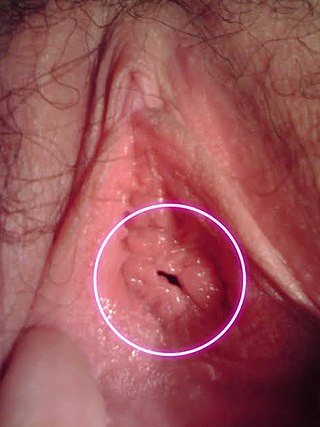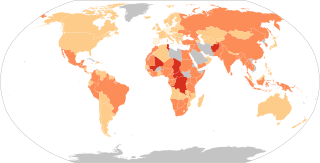Related Research Articles

Sexual intercourse is sexual activity involving the insertion and thrusting of the male penis inside the female vagina for sexual pleasure, reproduction, or both. This is also known as vaginal intercourse or vaginal sex. Other forms of penetrative sexual intercourse include anal sex, oral sex, fingering and penetration by use of a dildo. These activities involve physical intimacy between two or more individuals and are usually used among humans solely for physical or emotional pleasure and can contribute to human bonding.

In mammals, the vagina is the elastic, muscular part of the female genital tract. In humans, it extends from the vestibule to the cervix. The outer vaginal opening is normally partly covered by a thin layer of mucosal tissue called the hymen. At the deep end, the cervix bulges into the vagina. The vagina allows for sexual intercourse and birth. It also channels menstrual flow, which occurs in humans and closely related primates as part of the menstrual cycle.

The hymen is a thin piece of mucosal tissue that surrounds or partially covers the vaginal opening. A small percentage are born with hymens that are imperforate and completely obstruct the vaginal canal. It forms part of the vulva, or external genitalia, and is similar in structure to the vagina. The term comes straight from the Greek, for 'membrane'.
Dyspareunia is painful sexual intercourse due to medical or psychological causes. The term dyspareunia covers both female dyspareunia and male dyspareunia, but many discussions that use the term without further specification concern the female type, which is more common than the male type. In females, the pain can primarily be on the external surface of the genitalia, or deeper in the pelvis upon deep pressure against the cervix. Medically, dyspareunia is a pelvic floor dysfunction and is frequently underdiagnosed. It can affect a small portion of the vulva or vagina or be felt all over the surface. Understanding the duration, location, and nature of the pain is important in identifying the causes of the pain.

Episiotomy, also known as perineotomy, is a surgical incision of the perineum and the posterior vaginal wall generally done by a midwife or obstetrician. This is usually performed during second stage of labor to quickly enlarge the aperture allowing the baby to pass through. The incision, which can be done from the posterior midline of the vulva straight toward the anus or at an angle to the right or left, is performed under local anesthetic, and is sutured after delivery.
Sexual dysfunction is difficulty experienced by an individual or partners during any stage of normal sexual activity, including physical pleasure, desire, preference, arousal, or orgasm. The World Health Organization defines sexual dysfunction as a "person's inability to participate in a sexual relationship as they would wish". This definition is broad and is subject to many interpretations. A diagnosis of sexual dysfunction under the DSM-5 requires a person to feel extreme distress and interpersonal strain for a minimum of six months. Sexual dysfunction can have a profound impact on an individual's perceived quality of sexual life. The term sexual disorder may not only refer to physical sexual dysfunction, but to paraphilias as well; this is sometimes termed disorder of sexual preference.

Penile fracture is rupture of one or both of the tunica albuginea, the fibrous coverings that envelop the penis's corpora cavernosa. It is caused by rapid blunt force to an erect penis, usually during vaginal intercourse, or aggressive masturbation. It sometimes also involves partial or complete rupture of the urethra or injury to the dorsal nerves, veins and arteries.

In gynecology, a rectocele or posterior vaginal wall prolapse results when the rectum bulges (herniates) into the vagina. Two common causes of this defect are childbirth and hysterectomy. Rectocele also tends to occur with other forms of pelvic organ prolapse, such as enterocele, sigmoidocele and cystocele.

Vaginoplasty is any surgical procedure that results in the construction or reconstruction of the vagina. It is a type of genitoplasty. Pelvic organ prolapse is often treated with one or more surgeries to repair the vagina. Sometimes a vaginoplasty is needed following the treatment or removal of malignant growths or abscesses to restore a normal vaginal structure and function. Surgery to the vagina is done to correct congenital defects to the vagina, urethra and rectum. It may correct protrusion of the urinary bladder into the vagina (cystocele) and protrusion of the rectum (rectocele) into the vagina. Often, a vaginoplasty is performed to repair the vagina and its attached structures due to trauma or injury. Labiaplasty, which alters the appearance of the vulva, can be performed as a discrete surgery, or as a subordinate procedure within a vaginoplasty.

A rectovaginal fistula is a medical condition where there is a fistula or abnormal connection between the rectum and the vagina.

The rectouterine pouch is the extension of the peritoneum into the space between the posterior wall of the uterus and the rectum in the human female.

The fornices of the vagina are the superior portions of the vagina, extending into the recesses created by the vaginal portion of cervix. The word fornix is Latin for 'arch'.

Rape is a type of sexual assault involving sexual intercourse or other forms of sexual penetration carried out against a person without their consent. The act may be carried out by physical force, coercion, abuse of authority, or against a person who is incapable of giving valid consent, such as one who is unconscious, incapacitated, has an intellectual disability, or is below the legal age of consent. The term rape is sometimes used interchangeably with the term sexual assault.

Non-penetrative sex or outercourse is sexual activity that usually does not include sexual penetration. It generally excludes the penetrative aspects of vaginal, anal, or oral sex, but includes various forms of sexual and non-sexual activity, such as frottage, manual sex, mutual masturbation, kissing, or cuddling. Some forms of non-penetrative sex, particularly when termed outercourse, include penetrative aspects, such as penetration that may result from forms of fingering or oral sex.
A vaginal disease is a pathological condition that affects part or all of the vagina.

A perineal tear is a laceration of the skin and other soft tissue structures which, in women, separate the vagina from the anus. Perineal tears mainly occur in women as a result of vaginal childbirth, which strains the perineum. It is the most common form of obstetric injury. Tears vary widely in severity. The majority are superficial and may require no treatment, but severe tears can cause significant bleeding, long-term pain or dysfunction. A perineal tear is distinct from an episiotomy, in which the perineum is intentionally incised to facilitate delivery. Episiotomy, a very rapid birth, or large fetal size can lead to more severe tears which may require surgical intervention.

Postcoital bleeding (PCB) is non-menstrual vaginal bleeding that occurs during or after sexual intercourse. Though some causes are with associated pain, it is typically painless and frequently associated with intermenstrual bleeding.
A urogenital fistula is an abnormal tract that exists between the urinary tract and bladder, ureters, or urethra. A urogenital fistula can occur between any of the organs and structures of the pelvic region. A fistula allows urine to continually exit through and out the urogenital tract. This can result in significant disability, interference with sexual activity, and other physical health issues, the effects of which may in turn have a negative impact on mental or emotional state, including an increase in social isolation. Urogenital fistulas vary in etiology. Fistulas are usually caused by injury or surgery, but they can also result from malignancy, infection, prolonged and obstructed labor and deliver in childbirth, hysterectomy, radiation therapy or inflammation. Of the fistulas that develop from difficult childbirth, 97 percent occur in developing countries. Congenital urogenital fistulas are rare; only ten cases have been documented. Abnormal passageways can also exist between the vagina and the organs of the gastrointestinal system, and these may also be termed fistulas.
Vaginal trauma is injury to the vagina. It can happen during childbirth, sexual assault, and accidental occurrences.
References
- 1 2 3 Anderson, Sarah; McClain, Natalie; Riviello, Ralph J. (2008-06-28). "Genital Findings of Women After Consensual and Nonconsensual Intercourse". Journal of Forensic Nursing. 2 (2): 59–65. doi:10.1111/j.1939-3938.2006.tb00060.x. ISSN 1556-3693. PMID 17073065. S2CID 38838082.
- 1 2 3 4 5 6 7 Frioux, Sarah M.; Blinman, Thane; Christian, Cindy W. (January 2011). "Vaginal lacerations from consensual intercourse in adolescents". Child Abuse & Neglect. 35 (1): 69–73. doi:10.1016/j.chiabu.2010.08.006. ISSN 0145-2134. PMID 21315449.
- 1 2 3 4 Uğurel, Vedat; Özer, Dilek Pınar; Varol, Füsun (May 2014). "A Rare Case of Rectovaginal Fistula Following Consensual Vaginal Intercourse". The Journal of Sexual Medicine. 11 (5): 1345–1348. doi:10.1111/jsm.12472. ISSN 1743-6095. PMID 24877178.
- ↑ Schmidt Astrup, Birgitte; Lykkebo, Annemette Wildfang (2014-10-23). "Post-coital genital injury in healthy women: A review". Clinical Anatomy. 28 (3): 331–338. doi:10.1002/ca.22476. ISSN 0897-3806. PMID 25346095. S2CID 43703076.
- 1 2 Symeonidis, Nikolaos; Ballas, Konstantinos; Micha, Aikaterini; Psarras, Kyriakos; Pavlidis, Theodoros (February 2015). "Consensual Intercourse Resulting in an Extensive Rectovaginal Tear: An Extremely Rare Occurrence". The Journal of Sexual Medicine. 12 (2): 572–575. doi:10.1111/jsm.12754. ISSN 1743-6095. PMID 25376118.
- 1 2 Hoffman, Barbara L. (2011). Williams Gynecology (2nd ed.). New York: McGraw-Hill Medical. ISBN 9780071716727.
- ↑ "Vagina: What's normal, what's not". Mayo Clinic. Retrieved 2018-02-10.
- ↑ "Vaginal Trauma: You Fell On What? | Texas Children's Hospital". www.texaschildrens.org. Retrieved 2018-02-10.
- ↑ "Genital Injury - Female". www.seattlechildrens.org. Retrieved 2018-02-10.
- ↑ Albers, L.; Borders, N. (2007). "Minimizing Genital Tract Trauma and Related Pain Following Spontaneous Vaginal Birth". Journal of Midwifery & Women's Health. 52 (3): 246–253. doi:10.1016/j.jmwh.2006.12.008. PMID 17467591 . Retrieved 2018-02-10.
- ↑ Greenberg's Text-Atlas of Emergency Medicine. Lippincott Williams & Wilkins. 22 November 2004. p. 318. ISBN 978-0-7817-4586-4 . Retrieved 15 October 2012.
- ↑ Yang, Kunlin; Liu, Yu; Wang, Wei; Xiao, Yunxiang; Li, Xuesong; Zhou, Liqun (January 2020). "Successful penile replantation after macroscopic repair using vein blood-letting therapy". Urology Case Reports. 28: 101069. doi:10.1016/j.eucr.2019.101069. ISSN 2214-4420. PMC 6864311 . PMID 31763173.